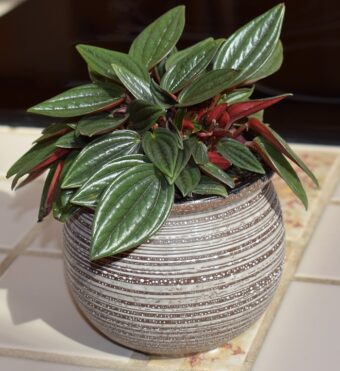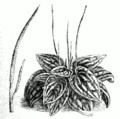In this article, we will be discussing the best way to grow Peperomias as houseplants in terms of the care they need, the varieties to grow and the problems that they can suffer from. Peperomias are delightful houseplants with their patterned, puckered and variegated leaves.
In this article, we will look at how to care for these beauties, what varieties to grow and what potential problems they suffer from. Before we dwell into all that, we must discover what a Peperomia is.
WHAT ARE PEPEROMIAS?
Peperomias fall into a large genus of the family Piperaceae, where Peperomia is one genus and Piper is the other. There are about 1600 species that have been recorded, all of them naturally found in the tropics and subtropics regions of the world. They tend to found in central and South America, but a small number is found in South Africa and other Africa countries.

Peperomias vary considerably in their appearance but most are compact, perennial, evergreen and epiphytes (grows on trees that are rotting).
They tend to have thick, stout stems and fleshy leaves. Most do not grow more than 30cm. As said earlier they vary in appearance with some have trailing stems, whilst others have much stouter, bulkier stems.
The leaves are the reason why this plant is bought as a houseplant. They can be smooth and fleshy, oval in shape, or maybe heart-shaped or lance-shaped. Some leaves are small only 2.5cm in size or they can be as big as 10cm.
The leaves can be puckered, striped, marbled and either all green or border with pale green, red or silver markings. The flowers that they produce are insignificant and can grow on distinctive, easily recognised cord-like spikes. The flowers produce a berry that eventually dries out, before splitting and revealing their seed that looks like little peppercorns.
They tend to be neat plants that are slow-growing and being specifically bred to produce a vast array of colures and leaf textures. They are useful plants that tend to be easy to grow and will tolerate a wide range of growing conditions.
THE BEST GROWING CONDITIONS FOR PEPERPOMIAS
GROWING MEDIA
These plants have a compact, shallow root system and therefore suitable to be grown in shallow planters. The best compost to grow them is in an ericaceous, peaty compost that is mixed with horticultural grit or perlite. A 50% mix of compost with 50% of grit or perlite is ideal. This will ensure that the plants’ root gets the air that it needs to flourish.

One strange thing about these plants is that they like to be undisturbed, as they hate being moved into new containers frequently because they prefer to be root bound. Potting on should only be carried out once every couple of years and only when the roots poke out of the pot and it is severely root-bound.
LIGHT
Peperomias are happy growing in bright, filtered light, as long as it is not too dark or too sunny. The plants also do well under fluorescent lighting making it an excellent office plant.
Too much direct sunlight will scorch the leaves and too little light will cause the plant to grow slowly.
TEMPERATURE
Ideally these plants like an average temperature above 10 degree Celsius and below 25 degree Celsius. They are not frost hardy and these plants do not like to be in cold draughts and so an area with constant temperature must be chosen.
HUMIDITY
This is one plant that needs high humidity and must be misted at least once a day or more in summer, especially if it is warm. It may be advised to place the plant on a tray of moist, expanded ceramic balls to increase the humidity in the vicinity of the plant.
WATERING

Due to the succulent leaves, they do not require a lot of water. This is why it is easy to overwater and it is best to allow the compost to dry out somewhat before watering once again. Ideally, 5cm below the top of the surface of the compost must be dry before watering is attempted again. In winter, cut back watering further only watering when the compost dries out at the recommended distance.
FERTILIZER
Use a balanced liquid houseplant fertiliser, dilute it and apply it once every month during the growing season. In winter, give the plant a rest by not feeding it. Avoid wetting the leaves whilst watering and fertilising as this can cause them to get fertilizer burn. It is better to apply it at a distance around the base of the plant.
PRUNING

These plants can benefit if they are pruned in early spring, as this will cause them to be healthier and bushier plants. This is easily achieved by pinching off the end of stems.
COMMON PROBLEMS
In general, they tend to be problem-free but they can suffer from pests and diseases. This includes root rot caused by overwatering, wilting caused by lack of air at the roots, moulds at the leaves and other fungal problems. They can be attacked by spider mites and fungus gnats. The best way to deal with these is to spray with a suitable systemic insecticide that can deal effectively with these specific pests.
VARIETIES TO GROW
There are numerous varieties to grow but the following are recommended for the home, all having different growing habits:
PEPEROMIA ARGYREIA (Water Melon Plant)
This 22.5cm tall Peperomia has a neat clump of broad spear-shaped leaves whose pattern looks like a watermelon with silver and green bands. Can be prone to mildew if the air is too stagnant.
PEPEROMIA CAPERATA (Emerald Ripple)
This is one Peperomia that is grown for its flowers as much as the leaves. The flowers are borne on strange-looking, solid, slightly curved, white spikes that appear over the attractive leaves. It is a 25cm tall plant that is compact and has clumps of small, heart-shaped, crinkly leaves. The leaves are usually dark green but a variegated variety does exist. It is very susceptible to attacks of mould and rot in winter, especially so if the humidity is high and the temperature is too low. Variegated forms grow less vigorously and are more sensitive to cold temperatures.
PEPEROMIA GLABELLA (Wax Privet)
This is similar in appearance to P. scandens but it shorter (up to 30cm in height) and the leaves are smaller. Can be a difficult plant to look after as both under and overwatering can cause the leaves to be shredded. Conditions must be steady and constant at all time for the plant to do well.
PEPEROMIA GRISEOARGENTEA (Ivy or Silver Leaf Peperomia)

This is similar to P. Caperata on growing habit but the leaves are larger and less crinkly. The leaves have an attractive pale silver sheen with red veins, where they can grow up to 1.8m in length. Keep it out of the cold as this will promote rotting at the base.
PEPEROMIA MAGNOLIIFOLIA (Desert Privet)

This is a neat, bushy plant with oval, fleshy leaves that are often variegated, emerald green and cream of if the ‘Variegata’ form is grown. ‘Green Gold’ has a richer, green colour and the leaf stalks are pinkish. A smaller plant that grows up to 30cm and one of the easier Peperomia to grow, as long as you do not overwater.
PEPEROMIA MARMORATA (Silver Heart)

A plant that resembles P. argyreia and P. caperata. It has a small, neat, rounded habit, where the leaves are reddish-green with a metallic sheen. Grow up to 30cm in height and is a good Peperomia to start with to see if you can grow Peperomias well.
PEPEROMIA OBTUSIFOLIA (Baby Rubber Plant)

The leaves of this 20cm plant are thicker and waxier than those of P. caperata. It looks like a miniature, branching rubber plant and it has an upright growing habit. The leaves are reddish at the edge and a variegated form exists ‘Variegata’, where it has broad, yellow edges to its mid-green leaves. Whitish flower spikes appear from summer to autumn and can be said to be one of the easiest Peperomias to grow.
PEPEROMIA ROTUNDIFOLIA (Trailing Jade)

This is a trailing Peperomia that has hanging stems and very small, thick, green, fleshy, succulent, button-like leaves that may twine in and out of each other. Another easy plant to look after, provided you get the watering right.
PEPEROMIA SCANDENS (Cupid Peperomia)

This trailing Peperomias can be grown as a climber or it can be allowed to trail. It is usually bought as a variegated form that has spear-shaped leaves that are green-cream variegated and has pinkish stems. Can grow up to 1.2m in length but may look better if it is trained up canes. When the plant is young it can be temperamental, especially of the temperatures and growing conditions are not met and steady. Draughts will cause it to lose leaves and other Peperomias tend not to be as fussy.
CONCLUSIONS
In this article, we have discussed the best way to grow Peperomias, in their care, the problems that they can suffer from and the best varieties to grow. They tend to be compact plants unless you are growing them as a trailer. Most are easy to look after providing that you get the balance between temperature, ventilation and humidity right. Otherwise, the plant can suffer from fungal problems.
They are wonderfully colourful and interesting plants to have in your home and it is about to improve their appearance.
If you have any questions or comments that you wish to make on Peperomias, please do so in the comment box below.
Happy Peperomia growing.
